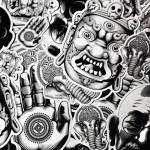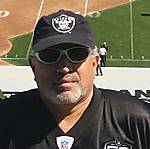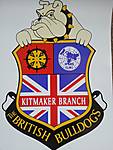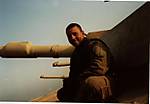Hi, All! I've been using TESTORS MODEL MASTER II ENAMELS and their regular MODEL MASTER line of paints ever since they first hit the market way back when... I use TESTORS Air Brushing Enamel Thinners AND their Lacquer Thinners for use with their METALIZER LACQUERS, getting great results. I use my 2 PAASCHE H1 Fine Tip Single Action Airbrushes and my BADGER 200 Single Action for regular spraying and my BADGER 200G Gravity-Feed Single Action for some really great dust, smoke, streaking effects and spot-work as well. Why do I like single-action airbrushes? Because I can get the same results with them as with dual-action brushes, for half the expense. It takes a lot of practice and patience, but it's worth it in the end... I don't stick to the same air-pressure and/or paint flow adjustments- That's what all those great little weegies and whatcha-callits on the airbrushes and compressors are for. ALL of my air-lines have water-traps; You can save yourself A LOT of headaches by installing those things. I don't quite get the reasoning behind using "Safe, Non-Toxic" Water-Based Acrylics and then mixing them with "VERY TOXIC" Petroleum-Based Lacquer Thinners- You know, like "Oil & Water don't mix." That kind of defeats the whole purpose of using the water-based stuff, doesn't it? If one reads the chemical compositions of these "safe, non-toxic" paints and then does some serious diving into a chemistry book to find out what all those chemicals really are, one finds that they're really not that safe after all. I've been airbrushing for just over 50 years now. I'm 61, and I ALWAYS wear a 3-M mask with filters, I use a spray booth and my shop is well-ventilated when I'm airbrushing... I've tried just about every paint product on the market today. And you know what? I STILL come back to my old-fashioned TESTORS Enamels. But hey, that doesn't mean that I'm saying that all the other products out there are junk, I'm just saying that the MODEL MASTER ENAMELS work for me. MICRO-SCALE used to make petroleum-based Clear Flat, Clear Semi-Gloss, and Clear High-Gloss that I used to thin with their petroleum-based thinners. They worked great with their decals. For some REALLY GREAT high-gloss finishes, I used to add a few drops of the MICRO-SCALE Gloss into TESTORS Gloss Enamels, (Some of you may remember the little 1/4 Ounce TESTORS paints?) to shoot my custom-mixed colors on my 1/24 Classic Cars. Yes, there was a long drying time, but WHAT A FINISH! I'd place a plastic cake cover over the model after I sprayed the clear finish on it to keep the dust off, and the3n leave it alone for about a week or so... I didn't even have to hand rub a car or one of my 1/48 Late-WWII US NAVY aircraft for hours to get that "mirror-finish"... Tough as nails, too... That was my own version of "Wet-Look" paint. Then, all of a sudden, MICRO-SCALE switched their "Finishing Products" line to "safe" water-based stuff. It's good stuff, but I can't mix water-soluable clears into oil-based enamels... Oh well, c'est la vie... My whole point in all of this rambling is that modellers SHOULD try different products to find out what works best for THEM. There are SO MANY factors that one should take into consideration when we have trouble with painting, especially with airbrushes. How NEW are the paints and/or thinners? Are they properly stirred and thinned? Test your Airbrush AND Compressor Settings... Different settings for different paints DO matter... What is the weather like? A hot, humid day will have a different effect on paint than a cold, dry day. You can shoot paint made by manufacturer "A" with great results, and then you can get lousy results with manufacturer "B" even though you're using the same settings and mixtures as you did with manufacturer "A"!!! Check your moisture traps- DRY air flow is KEY for a smooth paint-job. Your airbrush will "spit" if you've got moisture in your lines. Make sure that all of your paint and air connections are tightened properly. Has the airbrush been properly cleaned? Personally, I will break down my airbrush and clean it thoroughly before I go to the next color. I like to dis-connect my color cup from the airbrush and then shoot air through it to evacuate any paint. Then, I shoot a few blasts of raw thinners through it 2 or 3 times, just to get any accumulated paint out of it. Then, I'll break the airbrush down completely to clean all of the separate parts. I then let the parts soak in a small jar of airbrush thinner. After 10-15 minutes, I'll swab all the different parts out with a Q-tip, a soft rag, and some pipe cleaners. To prevent any gumming up of thinner residues inside the airbrush, I'll let the parts soak for a little while in a small jar of 92-95% Isopropyl Alcohol. The alcohol dissipates the thinner residues, and it air-dries in nothing flat. Make sure that all of your cleaning agents have been COMPLETELY removed from your airbrush. That's KEY to preventing unpleasant surprises down the road. While all this cleaning/soaking is going on, I've already got one of my other airbrushes ready to go on to the next color- That's why I use multiple airbrushes and compressors... I also keep several jars of airbrush thinners on hand for cleaning up light, medium and dark paints. That helps to keep cross-contamination down to a minimum between colors. Yeah, I'm lucky in that I have a good-sized workshop, with 4 different work benches- sort of like an "assembly line" arrangement. I can honestly say that it took me a lifetime to accumulate all of this stuff and experience. Sorry that I got carried away with this "lecture", but paying attention to all of these things will definitely keep your quality at a high level. It's not necessarily the PAINT'S FAULT- It could be the state of your equipment. Hope this helps in just a little way- ENJOY!!!


































